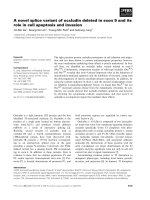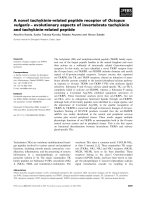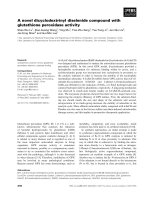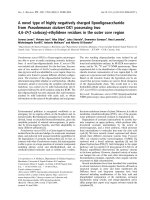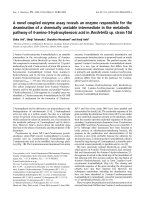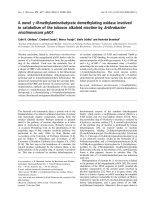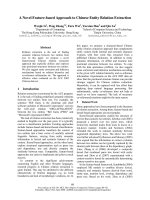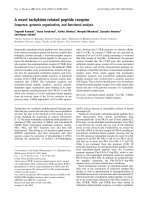Báo cáo khoa học: A novel metallobridged bis(b-cyclodextrin)s fluorescent probe for the determination of glutathione doc
Bạn đang xem bản rút gọn của tài liệu. Xem và tải ngay bản đầy đủ của tài liệu tại đây (353.95 KB, 8 trang )
A novel metallobridged bis(b-cyclodextrin)s fluorescent
probe for the determination of glutathione
Bo Tang, Fang Liu, Kehua Xu and Lili Tong
College of Chemistry, Chemical Engineering and Materials Science, Shandong Normal University, Jinan, China
Reduced glutathione (GSH: c-Glu-Cys-Gly), a princi-
pal non-protein thiol compound, plays an important
role in many biological processes such as transport,
protein synthesis, catabolism and metabolism [1]. It
can also protect cells against reactive oxygen species
and help them maintain an adequate intracellular
redox status [2]. Thus, the quantitative detection of
GSH is very important for investigating biological pro-
cesses. Many methods have been developed to deter-
mine GSH, including HPLC [3,4], electrochemistry
[5,6], spectrofluorimetry [7,8] and so on. Although
these methods are currently available for GSH deter-
mination, most of them are complicated and inconve-
nient to operate. The determination of GSH in plasma
is particularly challenging because redox conditions
change rapidly after blood collection [9,10]. Therefore,
a rapid and simple method for the analysis of GSH in
plasma is needed.
Cyclodextrins (CDs) are a class of cyclic oligosac-
charides with six to eight d-glucose units linked by
a-1,4-glucose bonds. They possess a hydrophobic
cavity capable of including a variety of hydrophobic
compounds via host–guest complexation [11]. They are
also widely used as a solubilizer because of their
hydrophilic exterior [12,13]. Among various functional
CDs, bridged bisCDs, which comprise two CD cavities
linked by a functional bridged has received great
attention [14]. In comparison with native CDs and
mono-modified CDs, bridged bisCDs exhibit signifi-
cant high-binding ability and molecular recognition
through the cooperative binding of two adjacent CD
units [15]. Furthermore, metallobridged bis(b-CD)s can
afford more stable inclusion complexes with guest
molecules through the cooperative binding of two
b-CD cavities and the additional interactions between
the coordinated metal and the guest molecule [16].
Keywords
competitive complexation; glutathione;
metallobridged bis(b-cyclodextrin)s;
molecular recognition; spectrofluorimetry
Correspondence
B. Tang, College of Chemistry, Chemical
Engineering and Materials Science,
Engineering Research Center of Pesticide
and Medicine Intermediate Clean
Production, Ministry of Education, Key
Laboratory of Molecular and Nano Probes,
Ministry of Education, Shandong Normal
University, Jinan 250014, China
Fax: +86 531 8618 0017
Tel: +86 531 8618 0010
E-mail:
(Received 30 November 2007, revised 13
January 2008, accepted 25 January 2008)
doi:10.1111/j.1742-4658.2008.06310.x
A novel metallobridged bis( b-cyclodextrin)s 2 [bis(b-CD)s 2] was synthesized
and characterized by means of
1
H NMR, IR, element analysis and redox
iodometric titration. The fluorescence of metallobridged bis(b-CD)s 2
was weak compared with bis(b-CD)s 1 because of the paramagnetism of
copper (II) ions. Glutathione was able to form complexes with copper (II)
derived from the metallobridged bis(b-CD)s 2. This competitive complexa-
tion with copper (II) may lead to a significant fluorescence recovery of the
bis(b-CD)s. Therefore, a rapid and simple spectrofluorimetric method was
developed for the determination of glutathione. The analytical application
for glutathione was investigated in NaCl ⁄ P
i
(pH 6.00) at room temperature.
The linear range of the method was 0.30–20.0 lmolÆL
)1
with a detection limit
of 63.8 nmolÆL
)1
. There was no interference from the plasma constituents.
The proposed method had been successfully used to determine glutathione in
human plasma.
Abbreviations
bis(b-CD), bis(b-cyclodextrin); CD, cyclodextrin; GSH, glutathione.
1510 FEBS Journal 275 (2008) 1510–1517 ª 2008 The Authors Journal compilation ª 2008 FEBS
In this study, we synthesized a novel fluorescent
bis(b-CD)s 1 containing two metal-binding sites and
two naphthyl fluorophores (Scheme 1). The compound
showed satisfactory water solubility because of the two
b-CDs. Complexes 2 were formed when copper (II)
ions were added to bis(b-CD)s 1, at the same time, flu-
orescence quenching was discovered. Afterwards, the
addition of GSH to 2 induced a recovery of fluores-
cence (Scheme 2). Based on this principle, we devel-
oped a rapid and simple spectrofluorimetric method
for the analysis of GSH. The proposed method has
been successfully applied to the determination of GSH
in human plasma.
Results and Discussion
Metal coordination and stoichiometry
Job’s experiments were performed to explore the coor-
dination stoichiometry of the bis(b-CD)s 1–copper (II)
complex in aqueous solution as described previously
[16]. A representative Job’s plot for the coordination of
bis(b-CD)s 1 with copper (II) chlorate is shown in
Fig. 1. The plot for the 1 ⁄ Cu
2+
system showed a
maximum at 0.67 which corresponded to a 1 ⁄ Cu
2+
stoichiometry of 1 : 2. This indicates that one
Scheme 1. Synthesis of the novel metallo-
bridged bis(b-CD)s.
Scheme 2. The detection mechanism.
0.2 0.4 0.6 0.8 1.0
0.00
0.02
0.04
0.06
0.08
0.10
0.12
0.14
0.16
0.18
Relative absorbance (a.u.)
[Cu
2+
] / ([Cu
2+
]+[1])
Fig. 1. Job’s plot of the 1 ⁄ Cu
2+
system at 349 nm.
[1] + [Cu
2+
] = 1.00 · 10
)4
molÆL
)1
; pH 6.00.
B. Tang et al. Glutathione determination using bis(b-CD)s
FEBS Journal 275 (2008) 1510–1517 ª 2008 The Authors Journal compilation ª 2008 FEBS 1511
bis(b-CD)s 1 could bind two copper (II) ions, as illus-
trated in Scheme 1.
Excitation and emission spectra
Following the procedure described below, the excita-
tion (left) and emission (right) spectra were scanned
(Fig. 2). The maximum excitation and emission wave-
lengths were 365 and 480 nm respectively. The fluores-
cence intensity of metallobridged bis(b-CD)s 2 was
weak compared with bis(b-CD)s 1. A significant recov-
ery of fluorescence was observed when GSH was
added to metallobridged bis(b-CD)s 2 in this analytical
system.
Influence of pH
Because of the instability of CD and the amido bond
at very low pH, the use of strongly acidic solution was
avoided [17]. Moreover, copper (II) will deposit in
alkali solution. Thus the optimal pH of the system was
in the range 4.00–9.00. The results are shown in Fig. 3.
As can be seen, the fluorescence intensity was relatively
high and remained almost constant over the pH range
5.00–6.50. Therefore, a pH of 6.00 was fixed using
NaCl ⁄ P
i
buffer.
The effect of the buffer is lost if too small a quantity
is used. Whereas if the amount of buffer is excessive,
the ionic strength is too great, which influences the flu-
orescence intensity. Therefore, the influence of the vol-
ume of buffer was measured. Because the volume of
buffer added (1.00–3.00 mL) had little effect on the
fluorescence intensity, 2.00 mL of buffer was chosen in
subsequent experiments.
Influence of the concentration of metallobridged
bis(b-CD)s 2
The influence of the concentration of 2 on fluorescence
intensity is shown in Fig. 4. As can be seen, as the
concentration of 2 increased, the fluorescence intensity
of the system also increased slightly. We therefore used
2.00 mL of 2.00 · 10
)4
molÆL
)1
metallobridged bis(b-
CD)s 2.
Influence of reaction time
The effect of reaction time was studied, the result
(Fig. 5) showed that the fluorescence intensity reached
a maximum after the reagents had been added for
300 320 340 360 380
400
420 440 460 480 500 520 540 560 580 600
0
500
1000
1500
2000
2500
3000
3500
4000
4500
3
3
2
2
1
1
1:bis(β-CD)s1
2:metallobridged
bis(
β-CD)s2
3:metallobridged
bis(
β-CD)s2+GSH
Fluorescence intensity (a.u.)
Wavelength (nm)
Fig. 2. Excitation (left) and emission (right) spectra. [bis(b-
CD) 1] = 2.00 · 10
)5
molÆL
)1
; [metallobridged bis(b-CD) 2]=
2.00 · 10
)5
molÆL
)1
; [GSH] = 5.00 · 10
)6
molÆL
)1
; pH 6.00.
150
200
250
300
350
Relative fluorescence intensity (a.u.)
4.00
5.00 6.00 7.00 8.00 9.00
pH
Fig. 3. Influence of pH on the fluorescence intensity.
[GSH] = 2.00 · 10
)6
molÆL
)1
;[2] = 4.00 · 10
)5
molÆL
)1
.
160
180
200
220
240
260
280
300
320
340
1.00 2.00 3.00 4.00 5.00 6.00 7.00 8.00
Relative fluorescence intensity (a.u.)
[metallobridged bis(β-CD)s 2] (10
–5
mol·L
–1
)
Fig. 4. Influence of the concentration of 2 on fluorescence inten-
sity. [GSH] = 2.00 · 10
)6
molÆL
)1
; pH 6.00.
Glutathione determination using bis(b-CD)s B. Tang et al.
1512 FEBS Journal 275 (2008) 1510–1517 ª 2008 The Authors Journal compilation ª 2008 FEBS
$ 10 min and remained constant for at least 1 h.
Hence, the reaction was left to proceed for 10 min,
and the fluorescence was then measured at room tem-
perature.
Influence of interference
The influence of the main constituents of plasma on
the determination of 2.00 · 10
)6
molÆL
)1
GSH were
studied. The criterion for interference was fixed at a
± 5.0% variation in the average fluorescence intensity
calculated for the established level of GSH. A 3000-
fold mass excess of plama over 2.00 · 10
)6
molÆL
)1
GSH was tested first. If interference occurred, the ratio
was gradually reduced until interference ceased. The
results are shown in Table 1 and it can be seen that
the determination was free from interference by the
constituents of plasma.
Mechanism
The novel fluorescent bis(b-CD)s 1 contained two
strong coordination sites for copper (II) ions and two
naphthyl fluorophores. The compound could be dis-
solved in aqueous solution and showed high binding
ability because of the two adjacent bis(b-CD)s.
Because of the conformation of the linker of 1, the
nitrogen atoms and amido bond formed two chelate
rings to coordinate with copper (II) ions. This coordi-
nation effect and the paramagnetism of copper (II)
ions induced fluorescence quenching. However, GSH
has a great propensity for forming complexes with
metal ions that have strong electrophilic characteristics
[18], such as copper (II) [19,20], mercury [21] and
cadmium [22]. In this system, the quenched copper (II)
complex 2 could interact with the thiol and amino of
GSH via a cooperative chelation effect [23,24], which
led to recovery of the fluorescence intensity of bis(b-
CD)s. Based on this principle, we developed a spectro-
fluorimetric method with high selectivity to determine
GSH in human plasma.
Analytical characteristics
Under optimum experimental conditions, there was a
linear relationship between fluorescence intensity and
GSH concentration in the range 0.30–20.0 lm with a
correlation coefficient of 0.9976 (Fig. 6). The regres-
sion equation was F = 2644.17 + 63.98 [GSH] (lm).
The detection limit, as defined by IUPAC [25], was
determined to be 63.8 nmolÆL
)1
, according to the
formula C = KS
0
⁄ S, where K = 3 (standard devia-
tion = 1.36), obtained from a series of 11 reagent
blanks, and S is the slope of the standard curve. The
relative standard deviation was 2.5%, obtained from a
series of 11 standards each containing 2.00 lm GSH.
When the concentration of GSH exceeded that of
metallobridged bis(b-CD)s 2 by as much as 100-fold,
a decrease in fluorescence intensity was discovered.
This is consistent with that previously reported by
Liu et al. [16].
10 20 30 40 50 60
100
120
140
160
180
200
220
240
260
280
300
320
340
0
Relative fluorescence intensity (a.u.)
Time (min)
Fig. 5. Effect of reaction time on fluorescence intensity.
[GSH] = 2.00 · 10
)6
molÆL
)1
;[2] = 4.00 · 10
)5
molÆL
)1
; pH 6.00.
Table 1. Interferences of various coexisting biological substances.
Coexisting substance
Concentration
(molÆL
)1
)
Relative error
(%)
K
+
6.0 · 10
)3
)3.7
Na
+
6.0 · 10
)3
)3.0
Ca
2+
1.6 · 10
)3
1.4
Mg
2+
2.4 · 10
)4
4.2
Zn
2+
6.0 · 10
)4
1.2
Fe
2+
1.0 · 10
)4
)4.4
Fe
3+
6.0 · 10
)5
)3.6
Arginine 1.0 · 10
)4
3.5
L-Phenylalanine 2.0 · 10
)5
4.6
Lysine 2.0 · 10
)5
3.1
L-Cysteine 1.0 · 10
)4
4.3
Tyrosine 1.0 · 10
)4
)4.5
Bilirubin 2.0 · 10
)5
4.8
Glucose 6.0 · 10
)5
)2.6
Cholesterol 1.0 · 10
)4
3.5
Ascorbic acid 1.0 · 10
)3
)3.3
Uric acid 4.0 · 10
)4
4.1
Gly–Leu 2.0 · 10
)4
2.7
Gly–Gly–Gly 2.0 · 10
)4
1.5
Gly–Gly 2.0 · 10
)4
2.3
Gly–Phe 8.0 · 10
)5
4.4
Gly–Pro 6.0 · 10
)4
3.5
Leu–Gly–Gly 8.0 · 10
)4
2.9
Leu–Gly 8.0 · 10
)4
4.3
B. Tang et al. Glutathione determination using bis(b-CD)s
FEBS Journal 275 (2008) 1510–1517 ª 2008 The Authors Journal compilation ª 2008 FEBS 1513
Applications
Sample collecting and processing
Fasting venous blood (5.00 mL) was routinely col-
lected from the author Y. Liu, and transferred to a
10 mL centrifuge tube containing heparin sodium as
an anticoagulant. The blood was immediately centri-
fuged at 1000 g for 1 min at room temperature to
remove cells and platelets [10]. Afterwards, 0.50 mL
of absolute alcohol was added to the plasma
with shaking. Plasma proteins were precipitated
and removed by centrifugation. The final plasma
samples used in the determination of GSH were
obtained.
Determination of GSH in plasma and accuracy
assessment by recovery experiments
In order to evaluate the applicability of the proposed
method, fluorescence determination in plasma was per-
formed according to the following procedures. Into a
series of 1.00-mL Eppendorf microtubes were sequen-
tially added different aliquots of the plasma samples,
GSH stock solution (3.00 · 10
)4
molÆL
)1
), 0.04 mL of
1.00 · 10
)3
molÆL
)1
metallobridged bis(b-CD) 2 and
0.20 mL of 0.10 molÆL
)1
NaCl ⁄ P
i
(pH 6.00). The
experimental data are shown in Table 2. The mixture
was diluted to mark with ultra-pure water, shaken
thoroughly and equilibrated at room temperature for
10 min. The fluorescence intensity of the solution was
measured at 365 ⁄ 480 nm.
The GSH content of the plasma was derived from
the standard curve and the regression equation. The
average recovery test was made using the standard
addition method, and the RSD was generally good
when obtained from a series of six plasma samples.
These results are also given in Table 2. Compared with
previously reported methods (Table 3), our results
indicate that the recovery and precision of our method
of determining GSH in plasma are satisfactory.
Conclusions
We synthesized a novel metallobridged bis(b-CD)s 2,
which afforded two hydrophobic binding sites coopera-
tively associating with the guest GSH and also provided
additional binding interactions between the hetero-
atoms of GSH and the coordinated metal center. GSH
was able to form complexes with copper (II) derived
from the metallobridged bis(b-CD)s 2. This competitive
0246810121416182022
2600
2800
3000
3200
3400
3600
3800
4000
Fluorescence intensity (a.u.)
[GSH] (µM)
Fig. 6. Linear plot of fluorescence intensity with increase in GSH
concentration. [2] = 4.00 · 10
)5
molÆL
)1
; pH 6.00. All spectra were
obtained under the optimum experimental conditions at
365 ⁄ 480 nm and room temperature.
Table 2. GSH determination in plasma samples (n =6,P = 95%).
Samples
Plasma
(mL)
GSH added
(l
M)
Measured
a
(lM)
RSD
(%)
Recovery
(%)
GSH content
of plasma (lM)
A 0.25 0 0.94 4.43 ) 3.77
B 0.50 0 2.02 3.97 – 4.05
C 0.75 0 3.66 3.56 – 4.88
A¢ 0.25 9.00 10.3 2.58 104 3.77
B¢ 0.50 6.00 7.94 3.47 98.7 4.05
C¢ 0.75 3.00 6.80 1.62 105 4.88
a
Mean of six determinations using the proposed method.
Table 3. Analytical characteristics compared with other methods reported.
Methods Linear range (l
M) Limit of detection GSH in plasma (lM)
HPLC [26] 0.81–13.02 0.13 l
M 3.39 ± 1.04
HPLC with fluorimetry [27] 0.2–20.0 14 f
M 1.82 ± 0.55
Proposed method 0.30–20.0 63.8 n
M 4.01 ± 0.38
Glutathione determination using bis(b-CD)s B. Tang et al.
1514 FEBS Journal 275 (2008) 1510–1517 ª 2008 The Authors Journal compilation ª 2008 FEBS
complexation with copper (II) may lead to a fluores-
cence recovery of the bis(b-CD)s. Based on this princi-
ple, we developed a spectrofluorimetric method with
high selectivity to determine GSH. The linear range of
the method was 0.30–20.0 lmolÆL
)1
with a detection
limit of 63.8 nmolÆL
)1
. There was no interference from
the plasma constituents. The proposed method was suc-
cessfully used to determine GSH in human plasma.
Experimental procedures
Apparatus and reagents
All spectrofluorimetric measurements were carried out with
an Edinburgh FLS920 spectrofluorimeter (Edinburgh Instru-
ments Ltd, Livingston, UK) equipped with a xenon lamp and
1.0 cm quartz cell. Absorption spectra were obtained from
UV-1700 (Shimadzu, Kyoto, Japan) UV–visible spectroph-
tometer. Infrared spectra were obtained from a PE-983G IR-
spectrophotometer (Perkin-Elmer, Palm Springs, CA, USA).
1
H NMR spectra were recorded on a Bruker Avance 300,
elemental analysis was performed on Perkin-Elmer Series P
CHNS ⁄ O analyzer. pH measurements was made with a pHS-
3 digital pH meter (Shanghai Lei Ci Device Works, Shanghai,
China) with a combined glass-calomel electrode. Centrifuga-
tion was carried out on a of Sigma 3K 15 centrifuge.
Reduced glutathione (99.8%) (Sigma, Mannheim, Ger-
many) was used without further purification. A stock
solution (1.00 · 10
)3
molÆL
)1
) of GSH was prepared with
ultra-pure water. b-CD (China Medicine Group Shanghai
Chemical Reagent Corporation, Shanghai, China) was puri-
fied by recrystallizing twice in ultra-pure water, followed by
vacuum drying at 95 °C for 24 h. 3-Amino-2-naphthoic
acid (Alfa Aesar, Word Hill, MA, USA) was used
without further purification. Mono(6-p-toluenesulfonyl-
6-deoxy)-b-cyclodextrin was prepared by reacting p-tosyl
chloride with b-CD in dry pyridine as described previously
[28,29]. Mono(6-p-toluenesulfonyl-6-deoxy)-b-cyclodextrin
was then converted to mono(6-aminoethylamino-6-deoxy)-
b-CD with 57.1% yield upon heating in excess ethylenedi-
amine at 75 °C under nitrogen for 7 h [30]. Compound 3,
oxamide bis(2-naphthyl) acid, was prepared according to the
procedure reported previously [31]. Other chemicals used
were of analytical reagent grade. The water used in this study
was purified using a Mill-Q (18.2 MWÆcm
)1
) water system. A
100 k Nanosep filter (Pall Corp., East Hills, NY, USA) and
micoron YM—30-30000 NMWL (Millipore, Billerica, MA,
USA) were used as ultra-purification instrumentation.
Synthesis of the novel bis(b-CD)s
Synthesis of compound 1
Mono (6-aminoethylamino-6-deoxy)-b-CD (2.00 g) was dis-
solved in dimethylformamide (50 mL) in the presence of a
small amount of 0.4 nm molecular sieves, and then 3
(0.21 g) was added. The mixture was stirred for 24 h at
70 °C under nitrogen. It was then allowed to stand for 5 h
until no further precipitate was deposited. The precipitate
was removed by filtration, and the filtrate evaporated to
dryness under reduced pressure. The residue was dissolved
in a minimum amount of hot water and poured into ace-
tone to give an orange precipitate. The orange precipitate
was purified by three recrystallization steps in ultra-pure
water. After the residue had been dried under a vacuum,
pure sample 1 was obtained with a 27% yield. UV ⁄ vis k
max
(H
2
O) ⁄ nm (log e): 348 (1.62).
1
H NMR (300 MHz, DMSO-
d
6
, TMS ppm): d2.00–3.00 (m, 14H); 3.30–3.80 (m, 84H);
4.00–4.95 (m, 28H); 5.50–6.00 (m, 26H); 7.01–7.08 (m, 2H);
7.23–7.29 (m, 2H); 7.40–7.48 (m, 2H); 7.60–7.70 (m, 2H);
7.90–7.97 (m, 2H); 8.30–8.35 (m, 2H). IR (KBr, cm
)1
):
m 3383.3, 2928.2, 2151.4, 1703.7, 1653.6, 1522.2, 1368.4,
1231.9, 1156.0, 1080.2, 1030.5, 945.7, 859.5, 755.9, 706.8,
579.5, 531.7. Elemental analysis calculated (%) for
C
112
H
164
O
72
N
6
: C, 48.98; H, 5.98; N, 3.06. Found: C,
48.77; H, 6.12; N, 3.24.
Synthesis of metallobridged bis(b-CD)s 2
According to the Liu et al. [16], bis(b-CD)s 1 was added
dropwise to a dilute aqueous solution of slightly excess cop-
per (II) chlorate in an ice-water bath. Several drops of chlo-
roform were further added, and the resultant solution was
kept at 5 °C for 2 days. The solution was then evaporated
under reduced pressure, and the precipitate formed was
collected by filtration, washed successively with a small
amount of ethanol and diethyl ether, and dried in vacuo to
give complex 2 as a green solid with 63% yield. UV ⁄ vis
k
max
(H
2
O) ⁄ nm (log e): 349.5(1.36). IR (KBr, cm
)1
): m
3419.5, 2930.3, 2048.1, 1637.6, 1536.4, 1406.0, 1337.1,
1301.6, 1238.3, 1155.3, 1121.3, 1078.7, 1028.9, 946.5, 856.1,
755.1, 706.6, 618.1, 579.2, 531.3. Elemental analysis calcu-
lated (%) for C
112
H
164
O
72
N
6
Æ2CuCl
2
: C, 44.59; H, 5.44;
N, 2.79. Found: C, 44.85; H, 5.72; N, 3.04.
Redox iodometric titration of copper (II) was also per-
formed to establish the coordination stoichiometry of com-
plex 2. We dissolved 1.508 g of complex 2 in 50 mL of
ultra-pure water, and added 25.00 mL of the complex 2
solution to a 125 mL Erlenmeyer flask. This was analyzed
iodometrically. Copper (II) was first reduced to Cu(I) by
KI according to the following reaction:
2Cu
2þ
þ 4I
À
! 2CuIðsÞþI
2
and the liberated I
2
was titrated against thiosulfate;
26.00 mL of 0.020 m Na
2
S
2
O
3
was required to titrate the
liberated I
2
according to the following reaction:
I
2
þ 2S
2
O
2À
3
! 2I
À
þ S
4
O
2À
6
The percentage of copper in the sample was 4.41. The
results confirmed that the mole ratio of complex 2 to
B. Tang et al. Glutathione determination using bis(b-CD)s
FEBS Journal 275 (2008) 1510–1517 ª 2008 The Authors Journal compilation ª 2008 FEBS 1515
copper (II) was 1 : 2, which was consist with the Job’ s plot
of the 1 ⁄ Cu
2+
system at 349 nm.
Calibration graph
Into a series of 10-mL colorimetric tube were sequenti-
ally added different aliquots of GSH stock solution
containing 0–2.00 · 10
)4
molÆL
)1
of GSH, 2.00 mL of
2.00 · 10
)4
molÆL
)1
metallobridged bis(b-CD)s 2 and
2.00 mL of 0.10 mol Æ L
)1
NaCl ⁄ P
i
(pH 6.00). The mixture
was diluted to mark with ultra-pure water, shaken thor-
oughly and equilibrated at room temperature for 10 min.
The fluorescent intensity of the solution was measured at
365 ⁄ 480 nm (Fig. 7).
Acknowledgements
This study was supported by the National Basic
Research Program of China (973 Program,
2007CB936000), National Natural Science Funds for
Distinguished Young Scholar (No.20725518), Major
Program of National Natural Science Foundation of
China (No.90713019), National Natural Science Foun-
dation of China (No.20575036) Important Project of
Natural Science Foundation of Shandong Province in
China (No.Z2006B09) and the Research Foundation
for the Doctoral Program of Ministry of Education
(No.20060445002).
References
1 Meiser A & Anderson M (1983) Glutathione. Annu Rev
Biochem 52, 711–760.
2 Sezginturk MK & Dinckaua E (2004) An amperometric
inhibitor biosensor for the determination of reduced
glutathione (GSH) without any derivatization in some
plants. Biosens Bioelectron 19, 835–841.
3 Fujita M, Sano M, Takeda K & Tomita I (1993)
Fluorescence detection of glutathione S conjugate with
aldehyde by high-performance liquid chromatography
with post-column derivatization. Analyst 118, 1289–1292.
4 Katrusiak AE, Paterson PG, Kamencic H, Shoker A &
Lyon AW (2001) Pre-column derivatization high-perfor-
mance liquid chromatographic method for determina-
tion of cysteine, cysteinyl–glycine, homocysteine and
glutathione in plasma and cell extracts. J Chromatogr
B: Biomed Appl 758, 207–212.
5 Sakhi AK, Russnes KM, Smeland S, Blomhoff R &
Gundersen TE (2006) Simultaneous quantification of
reduced and oxidized glutathione in plasma using a
two-dimensional chromatographic system with parallel
porous graphitized carbon columns coupled with fluo-
rescence and coulometric electrochemical detection.
J Chromatogr A 1104, 179–189.
6 Melnyk S, Pogribna M, Pogribny I, Hine RJ & James
SJ (1999) A new HPLC method for the simultaneous
determination of oxidized and reduced plasma amino-
thiols using coulometric electrochemical detection.
J Nutr Biochem 10, 490–497.
7 Imai K, Toyota T & Watanabe Y (1983) A novel fluor-
ogenic reagent for thiols: ammonium 7-fluorobenzo-
2-oxa-1,3-diazole-4-sulfonate. Anal Biochem 128, 471–
473.
8 Zhang JY, Hu ZD & Chen XG (2005) Quantification
of glutathione and glutathione disulfide in human
plasma and tobacco leaves by capillary electrophoresis
with laser-induced fluorescence detection. Talanta 65,
986–990.
9 Svardal AM, Mansoor MA & Ueland PM (1990)
Determination of reduced, oxidized, and protein-bound
glutathione in human plasma with precolumn derivati-
zation with monobromobimane and liquid chromato-
graphy. Anal Biochem 184, 338–346.
10 Mansoor MA, Svardal AM & Ueland PM (1992)
Determination of the in vivo redox status of cysteine,
cysteinylglycine, homocysteine, and glutathione in
human plasma. Anal Biochem 200, 218–229.
11 Szejtli J (1998) Introduction and general overview of
cyclodextrin chemistry. Chem Rev 98, 1743–1754.
12 Liu Y, Zhang N, Chen Y & Wang LH (2007) Fluores-
cence sensing and binding behavior of amin-
obenzenesulfonamidoquinolino-b-cyclodextrin to Zn
2+
.
Org Lett 9, 315–318.
13 Uekama K, Hirayama F & Irie T (1998) Cyclodextrin
drug carrier systems. Chem Rev 98, 2045–2076.
14 Liu Y & Chen Y (2006) Cooperative binding and multi-
ple recognition by bridged bis( b-cyclodextrin)s with
functional linkers. Accounts Chem Res 39, 681–691.
460 480 500 520 540 560 580
0
500
1000
1500
2000
2500
3000
3500
4000
4500
20 µM
18 µM
15 µM
10 µM
5.0 µM
1.0 µM
0.5 µM
0 µM
Fluorescence intensity (a.u.)
Wavelength (nm)
Fig. 7. Changes in fluorescence intensity after different concen-
trations of GSH were added to the analytical system under
optimal conditions at 365 ⁄ 480 nm and room temperature.
[2] = 4.00 · 10
)5
molÆL
)1
; pH 6.00.
Glutathione determination using bis(b-CD)s B. Tang et al.
1516 FEBS Journal 275 (2008) 1510–1517 ª 2008 The Authors Journal compilation ª 2008 FEBS
15 Breslow R, Halfon S & Zhang B (1995) Molecular rec-
ognition by cyclodextrin dimers. Tetrahedron 51, 377–
388.
16 Liu Y, Zhao YL, Chen Y, Ding F & Chen GS (2004)
Binding behavior of aliphatic oligopeptides by bridged
and metallobridged bis(b-cyclodextrin)s bearing an
oxamido bis(2-benzoic) carboxyl linker. Bioconjugate
Chem 15, 1236–1245.
17 Vanetten RL, Sebastian JF, Clowes GA & Bender MA
(1967) Acceleration of phenyl ester cleavage by cyclo-
amyloses. A model for enzymic specificity. J Am Chem
Soc 89, 3242–3253.
18 Loumbourdis NS (2006) Copper kinetics and hepatic
glutathione levels in the copper-exposed frog Rana rid-
ibunda after tetrathiomolybdate treatment. Bull Environ
Contam Toxicol 76, 522–528.
19 Hultberg M, Isaksson A, Andersson A & Hultberg B
(2007) Traces of copper ions deplete glutathione in
human hepatoma cell cultures with low cysteine con-
tent. Chem Biol Interact 167, 56–62.
20 Kumar DN, Singh BK, Garg BS & Singh PK (2003)
Spectral studies on copper(II) complexes of biologi-
cally active glutathione. Spectrochim Acta A 59, 1487–
1496.
21 Zalups RK & Lash LH (1996) Interactions between
glutathione and mercury in the kidney, liver and
blood. In Toxicology of Metals (Chang LW ed),
pp. 145–163. CRC Press, Boca Raton, FL.
22 Singhal RK, Anderson ME & Meister A (1987) Gluta-
thione, a first line of defense against cadmium toxicity.
FASEB J 1, 220–223.
23 Haddou HA, Wiskur SL, Lynch VM & Ansyln EV
(2001) Achieving large color changes in response to the
presence of amino acids: a molecular sensing ensemble
with selectivity for aspartate. J Am Chem Soc 123,
11296–11297.
24 Tobey SL & Anslyn EV (2003) Energetics of phosphate
binding to ammonium and guanidinium containing
metallo-receptors in water. J Am Chem Soc 125, 14807–
14815.
25 Irving HMNH & West TS (1981) IUPAC Compenduim
of Analytical Nomenclatrue, Definitive Rules. Pergamon
Press, Oxford.
26 Michelet F, Gueguen R, Leroy P, Wellman M, Nicolas
A & Siest G (1995) Blood and plasma glutathione mea-
sured in healthy subjects by HPLC: relation to sex,
aging, biological variables, and life habits. Clin Chem
41, 1509–1517.
27 Roman K, Pavla Z, Halka L, Otto K & Zuzana C
(2007) Determination of reduced and oxidized glutathi-
one in biological samples using liquid chromatography
with fluorimetric detection. J Pharmaceut Biomed 43,
1382–1387.
28 Melton LD & Slessor KN (1971) Synthesis of monosub-
stituted cyclohexaamyloses. Carbohyd Res 18, 29–37.
29 Tang B, Liang HL, Xu KH, Mao Z, Shi XF & Chen
ZZ (2005) An improved synthesis of disulfides linked
b-cyclodextrin dimer and its analytical application for
dequalinium chloride determination by spectrofluorime-
try. Anal Chim Acta 554, 31–36.
30 Tabushi I, Shimizu N, Sugimoto T, Shiozuka M &
Yamamura K (1977) Cyclodextrin flexibly capped with
metal ion. J Am Chem Soc 99, 7100–7102.
31 Nakatani K, Carriat JY, Journaux Y, Kahn O, Lloret
F, Renard JP, Pei Y, Sletten J & Verdaguer M (1989)
Chemistry and physics of the novel molecular-based
compound exhibiting a spontaneous magnetization
below Tc = 14 K, MnCu(obbz).cntdot.1H
2
O (obbz =
oxamidobis(benzoato)). Comparison with the antiferro-
magnet MnCu(obbz).cntdot.5H
2
O. Crystal structure
and magnetic properties of NiCu(obbz).cntdot.6H
2
O.
J Am Chem Soc 111, 5739–5748.
B. Tang et al. Glutathione determination using bis(b-CD)s
FEBS Journal 275 (2008) 1510–1517 ª 2008 The Authors Journal compilation ª 2008 FEBS 1517

